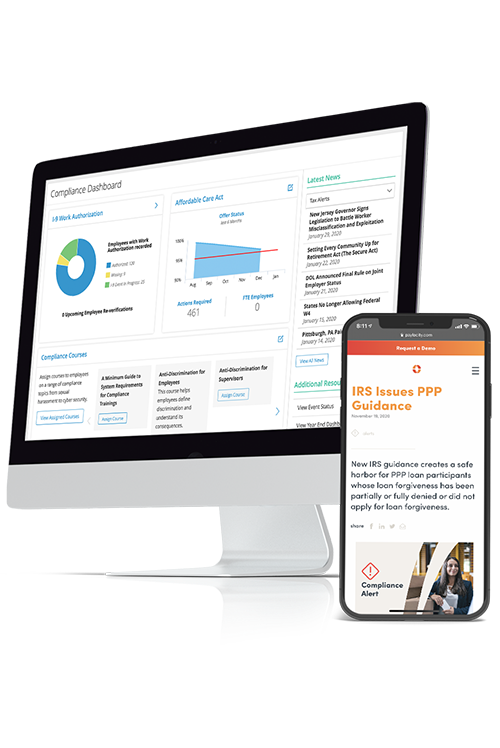resources
Congress Passes Omnibus Spending Bill with Secure 2.0
June 01, 2023

At A Glance
On December 29, 2022, President Biden signed H.R. 2617, the "Consolidated Appropriations Act" (CAA), also referred to as the Omnibus Spending Bill to fund the government through September 30, 2023. The 4,000-page bill contains multiple provisions of interest to employers, including the SECURE (Settling Every Community Up for Retirement Enhancement) 2.0 Act of 2022, "Secure 2.0".
Paylocity is in the process of determining the required product changes needed to support Secure 2.0, including the change to taxability of catchup contributions for certain participants and the opt in for part time employees. Stay tuned for future updates and communications.
What is the SECURE 2.0 Act of 2022?
The SECURE 2.0 Act of 2022 comprises 90 provisions aimed at reforming the retirement plan system, encouraging retirement savings, and reducing administrative requirements. SECURE 2.0 expands and builds upon the retirement program reforms initiated in the SECURE Act of 2019.
SECURE 2.0 Highlights include:
- Require automatic enrollment in employer-sponsored retirement plans
- Increase the catch-up limits for older Americans
- Catch-up contributions for high-earners must be Roth contributions
- Treat student loan payments as elective deferrals for the employer matching contribution purposes
- Permit employers to offer small-dollar incentives to employees to encourage participation
- Allow additional nonelective contributions to SIMPLE Plans and increase the contribution limits for SIMPLE Plans
- Create “Starter 401K” plans for employers who do not currently offer any
- Make it easier for part-time employees to become eligible to participate in their employer-sponsored retirement plan
- Allow employers to offer emergency savings accounts linked to their retirement plan
The following takes a further look at the provisions of Secure 2.0, along with their effective dates.
Expands automatic enrollment in retirement plans
Effective for plan years beginning after December 31, 2024, new 401K and 403(B) plans will be required to automatically enroll participants when eligible; employees may also opt out of coverage.
- The initial automatic enrollment deferral amount will be a minimum of 3% up to the maximum of 10%.
- The deferral amount will increase by 1% annually until it reaches 15% for safe harbor plans and 10% for non-safe harbor plans (up to 15% after 2025). All current 401(k) and 403(b) plans are grandfathered.
- There is an exception for small businesses with 10 or fewer employees, new businesses (i.e., those that have been in business for less than 3 years), church plans, and governmental plans.
- Effective for plan years beginning after December 31, 2024, employers in a PEP or MEP will be treated as maintaining a separate plan under grandfathering and exceptions, this would not apply to employers who newly join an existing PEP or MEP.
Catch–up limits increase for ages 60-63
Under current law, employees attaining age 50 can make catch-up contributions under a retirement plan more than the otherwise applicable limits. The limit for 2023 catch-up contributions is $7,500 for most plans, and $3,500 for SIMPLE plans and indexed for inflation.
- Effective for plan years beginning after December 31, 2024, the limits will increase to the greater of $10,000 or an amount equal to 150% of the applicable amount for individuals who have attained ages 60, 61, 62, and 63 before the end of the tax year.
- The limit for SIMPLE plans is $5,000 or 150% of the applicable amount for participants who have attained age 60, 61, 62, or 63 before the end of the tax year.
- The increased amounts are indexed for inflation after 2025.
- Effective for plan years beginning after December 31, 2023, plan participants who earn wages over $145,000 annually in previous plan year can only make catchup contributions as Roth contributions.
Catch-up contributions for high-earners must be Roth contributions
For plan years beginning after December 31, 2023, any catch-up contributions (contributions beyond the standard limits; currently allowed for participants who reach age 50 or greater during the plan year) made by an employee who earned over $145,000 (Medicare wages; indexed for inflation) in the prior year from the current employer must be treated as Roth (post-tax) contributions.
Treatment of student loan payments as elective deferrals for purposes of matching contributions.
For plan years beginning after December 31, 2023, student loan payments may be treated as elective deferrals for purposes of matching employee contributions. Any matching contributions for student loan payments are subject to the same vesting schedule as other matching employer contributions.
Small immediate financial incentives for contributing to a plan.
Employers will be permitted to offer de minimis financial incentives, not paid for with plan assets, such as low-dollar gift cards, to boost employee participation in workplace retirement plans by exempting de minimis financial incentives from section 401(k)(4)(A) and from the corresponding rule under section 403(b). This will be effective for plan years beginning after the date of enactment of this Act.
Allow additional nonelective contributions to SIMPLE plans.
Effective for tax years after December 31, 2023, employers will be permitted to make additional contributions to each employee of the plan in a uniform manner, provided that the contribution may not exceed the lesser of up to 10% of compensation or $5,000 (indexed).
Contribution limit for SIMPLE plans.
Effective for tax years after December 31, 2023, SECURE 2.0 increases the annual contributions and the catch-up limits based on employer size.
Employers with no more than 25 employees:
- Employee contribution limit increases from the 2023 limit of $15,500 to 110% of the contribution amount determined for 2024, plus indexing
- The catch-up limit increases from the 2023 limit of $3,500 to 110% of the catch-up limit determined for 2024, plus indexing.
Employers with 26-100 employees will be allowed to provide higher contribution limits, but only if providing one of the following options:
- Employer provides up to a 4% matching contribution or
- Employer provides a 3% nonelective contribution
SECURE 2.0 makes similar changes to the contribution limits for simple 401(k) plans.
Starter 401(k) plans for employers with no retirement plan.
For plan years beginning after December 31, 2023, employers that do not sponsor a retirement plan will be able to offer a starter 401(k) plan (or safe harbor 403(b) plan). A starter 401(k) plan (or safe harbor 403(b) plan) would generally require that all employees be default enrolled in the plan at a 3 to 15% compensation deferral rate. The limit on annual deferrals would be the same as the IRA contribution limit, which for 2022 is $6,000 with an additional $1,000 in catch-up contributions beginning at age 50.
Improving coverage for part-time workers.
The SECURE Act of 2019 provision provides that — except in the case of collectively bargained plans — employers maintaining a 401(k) plan must have a dual eligibility requirement under which an employee must complete either 1 year of service (with the 1,000-hour rule) or 3 consecutive years of service (where the employee completes at least 500 hours of service).
SECURE 2.0:
- Reduces the 3-year rule to 2 years, effective for plan years beginning after December 31, 2024.
- Provides that pre-2021 service is disregarded for vesting purposes, just as such service is disregarded for eligibility purposes under current law, effective as if included in the SECURE Act to which the amendment relates.
- Also extends the long-term part-time coverage rules to 403(b) plans that are subject to ERISA.
Tax Credits
New Plan Enrollment
The new provision creates incentives for small employers to encourage employees to plan for their retirement. The current three-year small business startup credit is the lesser of (1) 50% of startup costs, or (2) $5,000 for three years. SECURE 2.0 increases the startup credit from 50% to 100% for employers with up to 50 employees lowered from 100 employees. Small employers that join the multiple employer plan (MEP) may also be eligible for this credit.
In addition to the startup tax credit, small employers with a newly created retirement plan will be eligible for an employer contribution credit. It will be a set percentage of the employer's contribution, capped at $1,000 per employee. However, this is limited to employers with 50 or fewer employees. For employers with 51 to 100 employees, the set percentage declines by 25% each year over a five-year period (100% for the first year, 75% for the second year, etc.).
Small business’ employees with military spouses
Small employers with employee sizes up to 100 will be eligible for additional tax credits if they offer military spouses to participate in and fully vest in their deferred compensation plan, within the two months of their hire date. The tax credit is $200 per military spouse and up to $300 of a credit in employer contributions per everyone. This credit can be taken for the first three years.
Saver's Match
Beginning in 2027, the SECURE 2.0 Act revises the Saver's Credit (established in the Secure Act of 2019), newly renamed the Saver’s Match.
Effective for tax years beginning after December 31, 2026, lower-income retirement savers will be eligible to receive a government-funded matching contribution to their individual retirement account (IRA) or retirement plan in an amount up to 50% of their contributions (phased out as the individual’s income increases), capped at a maximum of $2,000 and reduced by certain distributions that are taken by the individual.
Required Minimum Distribution Age Increase
The Required Minimum Distribution Age (RMD) will increase from age 72 to age 73 for distributions after December 31, 2022 and will increase to age 75 beginning on January 1, 2033.
Emergency Savings Accounts
Employers will now have the option to offer non-highly compensated employees' pension-linked emergency savings accounts, these are also known as “sidecar” accounts.
- Employers may automatically opt employees into these accounts at no more than 3% of their salary and capped at $2,500 (or lower as set by the employer).
- Once the cap is reached, any additional contributions can be directed to the employee’s Roth defined contribution plan (if they have one) or stopped until the balance attributable to contributions falls below the cap. Contributions are made on a Roth-like basis and are treated as elective deferrals for purposes of retirement matching contributions with an annual matching cap set at the maximum account balance — i.e., $2,500 or lower as set by the plan sponsor.
- At separation from service, employees may take their emergency savings accounts as cash or roll it into their Roth defined contribution plan (if they have one) or IRA.
Next Steps
Employers have time before most of the Secure 2.0 provisions become effective. However, we recommend employers become familiar with the retirement plan changes in the coming months so that you can prepare and ensure your employees understand how the new changes could affect their enrollment and deferrals. Employers should use this time to consider the best options for future plan years. Paylocity will continue to provide additional details as more guidance becomes available and system updates are made.
Thank you for choosing Paylocity as your Payroll Tax and HCM partner. This information is provided as a courtesy, may change and is not intended as legal or tax guidance. Employers with questions or concerns outside the scope of a Payroll Service Provider are encouraged to seek the advice of a qualified CPA, Tax Attorney or Advisor.


